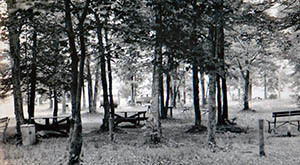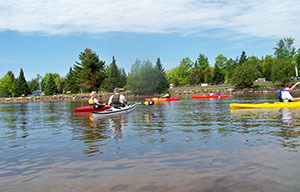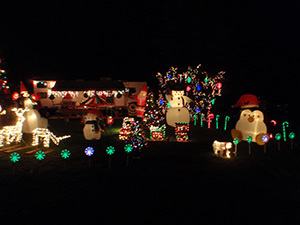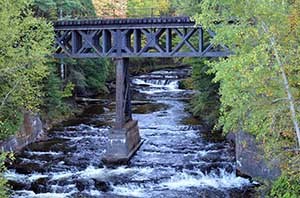The UP’s first mainland state park
This is part of a series of stories to mark the centennial of Michigan state parks. On May 12, 1919, the Michigan Legislature established the Michigan State Park Commission, paving the way for our state parks system. The Michigan Department of Natural Resources is celebrating this milestone throughout the year with special events, podcasts, historical stories, videos, geocaching and more. Find more details at Michigan.gov/StateParks100.
By JOHN PEPIN
Michigan Department of Natural Resources

In the land of the Ojibwa, along the shining shores of Keweenaw Bay, land was purchased for the creation of Baraga State Park early in the 1920s. Today, the park is a summertime gateway destination to a wide range of recreation and sightseeing opportunities in and around Baraga County.
Jesuit missionary Father Menard wintered near L’Anse in the early 1660s. Father Baraga, the “Snowshoe Priest,” set up a mission nearby in 1843.
The text of a Michigan historical marker said furs and fish figured prominently in the bay’s early history as a source of economic wealth, with the timber industry flourishing in the area in the late 19th century.
Development of the park began in 1924 and took a good while to complete. Early plans included potentially siting a fish hatchery next door. The park was the first mainland state park in the Upper Peninsula, established in 1922.
“We moved there, that was 1937, and there was nothing there but the house and they had two box toilets on the north side and two on the south side,” said Albert “Chink” Wallin, manager at the park from 1937 to 1974. “That’s all they had there, nothing else. And the tools they had was a wheelbarrow, a shovel and a rake. In fact, it was all swamp.”
|

The Works Progress Administration completed a lot of the work at the south end of the park, planting trees, developing features of the day-use area and beach on Lake Superior. The crews also helped enlarge the park.
Today, modern park improvements are in progress at Baraga State Park, which is situated about a mile south of the village of Baraga along U.S. 41. Once completed, the park will have 95 sites, including some 50-amp and full-hookup sites. There is also a mini-cabin and a tepee available for overnight lodging.
Activities at the park include hiking, kayaking, boating, fishing, off-road vehicle riding and bicycling. The park has a roughly 1-mile nature trail. There are historical attractions situated nearby, including a shrine to Bishop Baraga, with a towering statue that overlooks the expansive bay from the surrounding cliffs, an American Indian cemetery and other places associated with the Keweenaw Bay Indian Community.
Additional activities the area offers include birdwatching, nature and landscape photography, stargazing and wildlife viewing. Off-road vehicle riders can access the local trail system from the park.
|

Several activities are scheduled throughout the summer and fall at the park or nearby, including the Baraga County Lake Trout Festival in June, Christmas in July and the park’s Harvest Festival in the fall.
“Being centrally located in the western Upper Peninsula, a lot of visitors use Baraga State Park as a base camp to visit many locations in Baraga County,” said Kelly Somero, western U.P. recreation programmer with the Michigan Department of Natural Resources. “Visitors also stay here and travel to the Keweenaw Peninsula, the Quincy and Adventure mines or the Porcupine Mountains, returning to the park each evening.”
From secluded green forests and tumbling waterfalls to quiet lakes and rocky outcroppings with beautiful vistas, there are fantastic places nearby to visit, including several state forest rustic campgrounds, each associated with a water body.
These campgrounds are for those interested in an even quieter setting, with few amenities. Picnic tables, water pumps, a fire ring and a pit toilet are provided.
Among these, Big Eric’s Bridge has great spring and fall trout and salmon fishing on the Huron River; King Lake is a beautiful kayaking place with rock islands, loons, eagles and moose; Big Lake is a sandy-bottomed lake with access to the Baraga Plains and the Baraga Plains Off-Road Vehicle Trail and hiking at the Sturgeon River Gorge; and Deer Lake provides a secluded atmosphere with fishing and boating.
|

Michigan’s highest natural point, Mount Arvon, is not far from the park. The shores here are rugged and the waters protected and often peaceful. The communities of L’Anse and Baraga provide shops, places to eat and gasoline.
Baraga State Park is a beautiful place to visit. Throughout its history, park managers who have been assigned to the park have often spent a good deal of time there.
The first superintendent was Peter Foss, who was born in Norway, came to America as a boy and worked in the timber industry before being appointed to his post at the park.
Wallin was born in Nebagamon, Wisconsin. He was interviewed for an oral history project about the park in 2005. He died in Baraga in April 2012 at age 105.
“Now I can’t drive anymore so I take the lawnmower down to the restaurant, or then I go to the store, but I can’t walk anymore,” Wallin told his interviewer. “I’ll have to show you that lawnmower. You only live once they tell me. When you leave you don’t need nothing. I think we did pretty good on the park though.”
|
Check out previous Showcasing the DNR stories in our archive at Michigan.gov/DNRStories. To subscribe to upcoming Showcasing articles, sign up for free email delivery at Michigan.gov/DNR.
/Note to editors: Contact: John Pepin, Showcasing the DNR series editor, 906-226-1352. Accompanying photos and a text-only version of this story are available below for download. Caption information follows. Credit Michigan Department of Natural Resources, unless otherwise noted.
Text-only version of this story.
Bike: A young park visitor rides his bike through Baraga State Park.
Campground: An undated photograph shows the early days of Baraga State Park, which was established in 1922. Development began two years later.
Christmas: The campsite awarded best decorated during Christmas in July festivities at Baraga State Park in Baraga County.
Falls: The cascading Falls River in L’Anse rushed toward Lake Superior, not far south from Baraga State Park.
Kayaking: Kayaking classes, like the one shown here, are taught on the waters of Lake Superior at Baraga State Park.
Park: A undated photo shows the early days of Baraga State Park in Baraga County.
Sign: The entrance to Baraga State Park off U.S. 41 is shown.
Sturgeon: The beautiful Sturgeon River rolls through the countryside not too far from Baraga State Park./
|